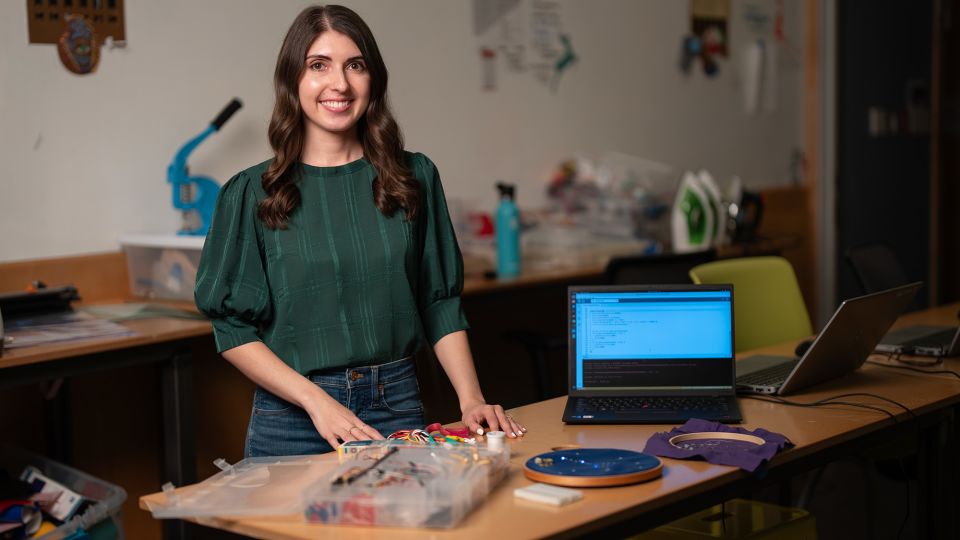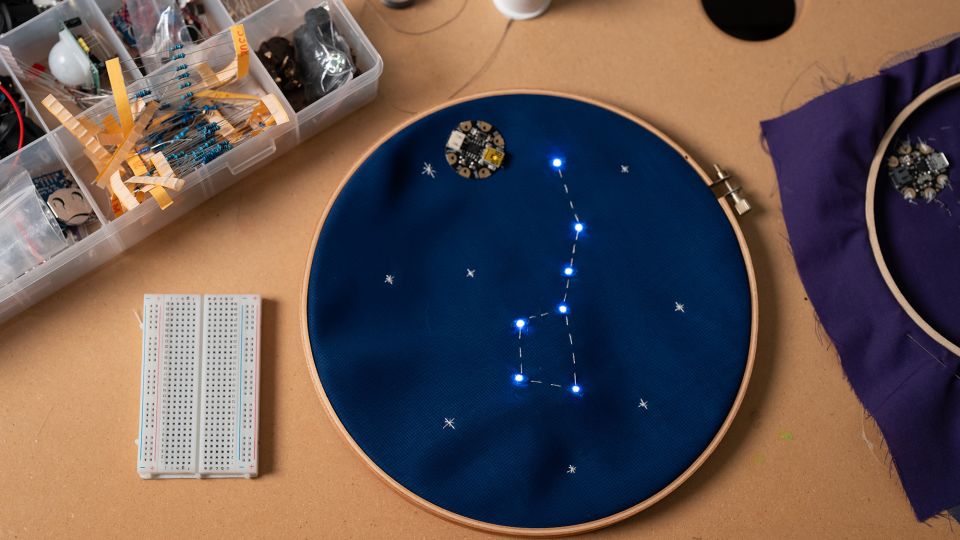Magic in Motion: Software Engineer Crafts Twirling, Illuminating Gowns
When Christina Ernst envisioned the idea for a self-twirling dress, she brought it to life and equipped it with robotic limbs designed to elevate the edge of an elegant pink frock, causing it to rotate from side to side. Her imagination also breathed life into a shimmering, fake-candle-adorned corset top, along with a grand cathedral gown featuring stained-glass-style sections that were capable of lighting up akin to nighttime window panes.
In the last year, this 28-year-old has garnered hundreds of thousands of followers thanks to her playful fashion ventures that blend coding and electronics. Hailing from Chicago, when Ernst isn't busy as a software engineer at Google’s West Loop location, she spends her time on "fashioneering" experiments at home before sharing them through tutorials on her site and updates across various social platforms. She Builds Robots She aims to inspire additional young women to pursue careers in STEM disciplines.
When I was young, I wished for more technological representations related to my passions in fashion, art, and illustration," she said during an interview at Chicago Public Library’s Maker Lab, where Ernst held a 12-week residency showcasing her design concepts. "These were subjects I adored, yet I didn’t think they connected well with technology... It's crucial for me to base my tutorials around topics many teenage girls are already interested in, so as to engage them effectively.
Ernst frequently ventures into realms of imagination, starting with her initial popular videos showcasing her Medusa outfit featuring multiple moving robotic snakes, one of which utilized AI face-tracking technology to establish eye contact. However, the "dumbest" creation she has produced using her computer engineering background—according to what appears in her most-viewed clip—was crafted specifically for a Halloween costume.
In this creation, she displays a tiny, motor-driven 3D-printed model resembling a well-known cartoon rat known for being enthusiastic about food. The miniature creature is attached to a headband and uses both of its front paws to lift strands of her hair gently as she chops an onion in the kitchen. She tested her interpretation of Remy from "Ratatouille" by initially using yarn instead of real hair to prevent discomfort. Following the positive response online—over 45 million views combined on Instagram and TikTok—to comments suggesting improvements, she decided to enhance her design even more.
The initial iteration simply involved his arms moving up and down. I programmed these movements to occur at random," she stated. "Many viewers suggested synchronizing it with my actions, and coincidentally, I possessed an accelerometer. Given how frequently this component is used, I dedicated a few days over the weekend to connect everything.
‘Magical’ technology
Ernst mentions that she often harbors several grand notions simultaneously swirling around in her head, occasionally lasting for months. However, these ventures aren’t intended to showcase the next big thing in either tech or fashion; rather, they serve as catalysts for dialogue among budding creators and stylists, encouraging them to view technology from an alternative perspective.
Technology truly seems miraculous to me... Whenever I mention crafting robotic attire, I strive for it not to resemble what others envision," she explained. "Maintaining a sense of marvel and playfulness is crucial to me. Each design aims to incorporate this element to attract individuals who may typically have little interest in engineering.

Although Ernst doesn't intend to make a more structured foray into fashion, robots walking down runways have produced several of the industry’s standout scenes. Back in 1998, Alexander McQueen orchestrated an intense piece of performance art where two robots sprayed paint onto a dress being modeled by Shalom Harlow. A couple of years back, Coperni collaborated with Boston Dynamics during Paris Fashion Week, featuring robotic dogs from the company interacting with models such as Lila Moss, helping them remove their outerwear and carry bags.
The awe-inspiring blend was something Ernst uncovered early in her career, thanks to her initial fashion endeavor in college: a Bluetooth-operated LED dress that could change colors, which she developed during a hackathon at the University of Illinois Urbana-Champaign.
She described the "aha" moment occurring when numerous girls visited her display, seeking guidance on replicating the dress. This made her recognize that fashion initiatives might serve as an entry point to STEM education. During her high school years, she excelled in mathematics competitions while also enjoying customizing her attire; however, choosing which path to pursue during university applications seemed like having to pick one over the other.
Many individuals believe that fashion has absolutely nothing to do with science; however, this notion is incorrect. According to Ernst, the evolution of computers shares roots with fabric history. The Jacquard loom, introduced in the early 1800s for weaving purposes, utilized a punched card system which later influenced the development of modern computers due to its employment of binary coding. "This connection runs quite deep," he added.

Embracing failure
In her work, Ernst integrates various fields and methods, including 3D modeling, laser cutting, manual dyeing, and knitting, as she mentioned. Due to this approach, she frequently creates preliminary versions of her projects using basic materials like cardboard "prior to utilizing advanced technology."
Since college, Ernst has explored various ways to design curriculum for students. She received a small grant in 2017 for her hackathon project to create introductory circuit projects with art and fashion in mind and provide them online for free. She also provided educational kits to five public schools in Chicago from 2022 to 2023.
And this past year, she was a maker-in-residence at Chicago Public Library, teaching free classes at the Harold Washington Library branch while growing her online audience. There, she taught people from all walks of life, from young students to parents to retirees. In one case, a Girl Scout leader who attended and learned to program a motor said she would teach the new skills to her troop, Ernst recalled, and offer a new electronics badge that members could earn.
During her residency, Ernst developed a fresh design for the library’s display window , a golden and blush-colored Phoenix dress adorned with feathers that move up and down when people touch a sensor panel on the display window. This attire pays homage to the Garden of the Phoenix, constructed in Jackson Park for the 1893 Chicago Exposition as an emblem of goodwill between the U.S. and Japan; although the garden was destroyed after World War II, it has since been restored.
Although Ernst initially intended to use motion detectors to trigger the dress, followed by integrating viewers' smartphones, she ultimately opted for a quicker fix with simpler light-sensitive photoresistors that activate upon being covered.
A lot of it comes down to experimenting and making mistakes," she explained. "My education in computer engineering along with my work experience in software development has honed my abilities in persistently troubleshooting issues and testing hypotheses. This carries over into my approach towards experimental fashion design, as I frequently create between 6 to 8 prototypes until I achieve a satisfactory result.
She has discovered that displaying or elucidating the failed iterations of her projects can be equally engaging for her audience at times.
I was astonished by the number of people who remarked that they enjoy viewing the failures," she stated. "They find value in looking at non-functional prototypes as well." She further explained, "This allows them to understand that it’s acceptable to encounter failure and essential to iterate—no one naturally knows how to accomplish these tasks from the start.
To receive additional news and newsletters, sign up for an account here.
Belum ada Komentar untuk "Magic in Motion: Software Engineer Crafts Twirling, Illuminating Gowns"
Posting Komentar